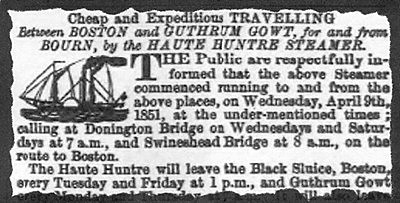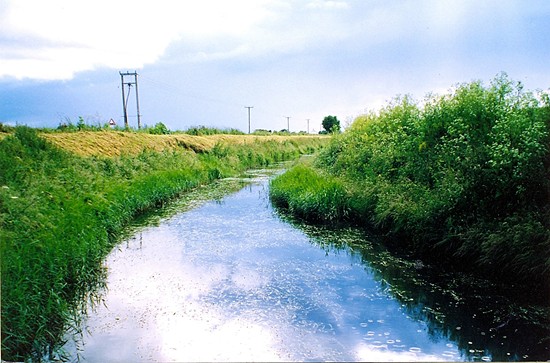|
Steamer trips from Bourne
It may seem fanciful but none the less true that steamer trips between Bourne and Boston were introduced as long ago as 1850. The voyage sounds even more incredible when we learn that they took place along the South Forty Foot Drain which was originally built to keep much of the surrounding farmland free from water to enable productive agriculture take place. The waterway, also known as the Black Sluice Navigation, is the main channel for land drainage in the Lincolnshire fens, running between the Black Sluice pumping station on the Haven river at Boston and Guthram Gowt at the southern upstream end, five miles to the east of Bourne. It dates from the 17th century during the early days of fen drainage and has been steadily improved since then, remaining navigable until 1971 although it is currently being upgraded as part of the Fens Waterways Link. Steamships came into practical use in the 19th century, sea travel until then being under sail, but mechanical propulsion had begun in Scotland in 1803 and continuous development produced the first Atlantic crossing in 1819. River trade was not new to Bourne although it was mainly commercial with coal and wood coming in from the east coast ports by sail driven cargo boats which returned with their holds full of skins and hides but the arrival of the steamers brought with them the possibility of faster journeys over shorter distances that would appeal to fare paying passengers and the Haute Huntre was specially designed for that purpose. The vessel built at Boston was given the ancient name for Holland Fen, the district through which it was planned to ply as a packet steamer. It was launched in August 1850, built entirely of iron, 70 feet long with a 10 ft. 6 in. beam, weighing 15 tons and powered by two 12 h p engines which had been placed amidships and as the waterway she was to sail was extremely narrow in some places a screw propeller was fitted in preference to paddles and placed under the stern where it would work in three feet of water at up to 250 revolutions a minute. Deck cabins were also available together with storage areas for grain and other cargoes with a capacity of 30 tons. “She has a peculiarly graceful sweep, sharp at the bows, and in form is very similar to the magnificent civic barges used on the Thames by the Corporation of London”, said the local newspaper and after a series of trials in October that year it was reported that the craft “had realised the expectations of her proprietors”. Few people travelled in those days and most rarely left their village or town because stagecoaches were expensive and Bourne had not yet joined the railway network and so the prospect of steamer trips to a big town were an exciting novelty and the owners anticipated a profitable venture. It was intended that the boat would ply a daily trade along the 24 miles of the South Forty Foot Drain from Black Sluice at Boston with various stops en route, the final destination being Guthram Gowt with carriages and wagons to take passengers and freight on the five mile journey to and from Bourne. The first steamer trip was planned for Wednesday 20th November 1850 but was cancelled at the last moment. “The proprietors are sorry to inform the public that though they have used every exertion, they find it impossible to start the steamer voyages and the necessary alterations will be immediately commenced and proceeded with as fast as possible”, said a public notice. Engineers later discovered that they had underestimated the power required to drive the boat and the boiler was not large enough to ensure the necessary speed for the journey but after a replacement was installed, the sailings began the following year and in April 1851 the company announced: “The steamer now runs regularly between Boston and Guthram. The new boiler and machinery answer exceedingly well; the speed attained being quite as great as the drainage commissioners will permit.” From then on, the Haute Huntre became a regular attraction for the people of Bourne, providing what the owners described as “cheap and expeditious travelling” for those on business as well as pleasure and even for those who wished to reach other parts of the country because sailing times of departure and arrival had been arranged to coincide with the railway timetable. Trips between Boston and Guthram Gowt were available every Tuesday and Friday and from Guthram to Boston every Monday and Thursday although return day trips were also available with an early start at 5 am from Guthram returning from Boston the same day at 3.30 pm. The steamer also made regular calls en route at Casswell’s Bridge, Nesslam Bridge, Donington Bridge, Swineshead Bridge and Clay Dyke with first and second class fares ranging from 4d. for the second class fare to the first stop en route to 2s. for the first class fare to Boston, with reduced fares for children. There were also special rates for market day in Boston but as this was a popular outing, all fares were 25% higher. Arrival time at Boston was scheduled to coincide with trains leaving for York, Lincoln and Hull and the return journey was also arranged to begin after the arrival of trains from these places. By 1851, an omnibus was being used to take people from outlying areas to catch the steamer at Guthram, notably from the villages north of Bourne such as Billingborough although the journey meant a 6 am start from outside the Fortescue Arms. The steamer was also used for day trips to bring the crowds from Bourne and district into Boston for big events such as Boston Fair which was held every May and in August 1853 many visitors joined the thousands who attended a big temperance gala and demonstration in the town which attracted almost 3,000 visitors who, according to a local newspaper, got there by “rail, van, cart and all other available conveyances and a good load from Horbling and Billingborough by the Haute Huntre steamer”. But the enterprise was not to last. Passenger numbers dwindled and profits fell, prompting some shareholders to sell their holdings and by 1854 the only trip still running was between the Black Sluice and Donington Bridge. That too was also doomed and on November 15th the steamer had stopped operating altogether and the company was trying to discharge its debts while the once grand Haute Huntre lay idle awaiting a buyer at its moorings in the shipyard at Boston.
WRITTEN MAY 2014
Go to: Main Index Villages Index |

